Floodplains, Fish & a Freeway
Few animals are more iconic for Washingtonians than salmon. The fish is a major barometer measuring environmental health; its decline represents the failures of our past and its recovery represents our desire to live in balance with the environment.
The story of the Spring Valley Ranch Restoration Project is not one of bureaucracy, but rather one of relationships. The solution to what potentially stopped a major freeway project was restoring a portion of Hylebos Creek that had been limiting salmon production for generations.
Hylebos Creek flows from the Hylebos Watershed to Commencement Bay in Tacoma, Wash. Sections of the stream provide rich salmon-bearing habitats despite the heavily residential and industrial areas through which they flow. There are gaps, however, that need restoration.
Joining Forces
Friends of the Hylebos is a grass-roots nonprofit organization that has worked with the community and local governments to protect and restore streams, wetlands and forests in the Hylebos Watershed since 1983.
In 2003, the Washington State Department of Transportation (WSDOT) was designing a project that would build new carpool lanes along a section of I-5 near Tacoma. The project was in need of a large wetland mitigation site.
The Friends of the Hylebos’ intimate familiarity with the needs of the surrounding watershed helped the WSDOT project team identify a special property that would become a crucial element of the freeway project.
This project is one piece of the Hylebos Creek Conservation Initiative, a 745-acre preservation and restoration effort including more than 10 miles of Hylebos Creek from the West Hylebos wetlands in Federal Way, Wash., to Commencement Bay. To date, more than 425 acres have been preserved.
WSDOT partnered with the Friends of the Hylebos and the city of Federal Way to create the Spring Valley Ranch Restoration Project. Preserving and restoring this important stretch of Hylebos Creek had been a top priority for the nonprofit and the city for many years, but the land was privately owned and the Friends of the Hylebos did not have the resources to acquire the land.
Using environmental mitigation funding from the I-5 project, WSDOT purchased the 28-acre Spring Valley Ranch property from a private landowner for $1.75 million in 2004.The group immediately began designing the restoration, working cooperatively with the Friends of the Hylebos, the city of Federal Way, the Puyallup Tribe of Indians and the Washington Department of Fish and Wildlife.
Operation Restoration
Restoration plans included returning approximately 1,400 ft of degraded Hylebos Creek spawning habitat and pasture land to its natural state. Crews reshaped the floodplain at Spring Valley Ranch on the west branch of Hylebos Creek, removing fill dirt, shaping wetlands and digging a new salmon-friendly stream channel. Originally, the creek ran straight and the surrounding land was cleared with only grass for vegetation.
Work kicked off in January 2007, with scores of volunteers planting more than 2,000 trees and shrubs along the site’s eastern boundary. A separate kick-off event, hosted by WSDOT, invited sixth graders from Federal Way Public Academy to release a large number of young salmon into Hylebos Creek, commemorating its planned restoration.
Later in 2007, MidMountain Contractors Inc. began the major part of the project, restoring the stream channel, removing fill dirt, re-establishing wetlands and planting more than 50,000 native trees and shrubs. Redirecting the creek restored the natural processes of the stream and surrounding wetland habitat. The new stream channel also included a new road crossing that greatly reduced flooding potential. Crews successfully opened the new channel in time for the return of fall-spawning salmon.
“The relationship that developed with Chris Carrel and the Friends of the Hylebos proved invaluable,” said WSDOT State Design Engineer Pasco Bakotich. “Never, on our own, could the department have gained the owner’s perspective of this natural resource that was shared by the Friends.”
Small Stream, Big Benefits
WSDOT has been making improvements to Hylebos Creek since the mid-1990s, creating and restoring wetlands, removing blocked culverts and rehabilitating more than 30 acres along the creek. The Spring Valley Ranch Restoration Project was the agency’s most substantial and meaningful contribution to preserving Hylebos Creek and the surrounding environment. The Friends of the Hylebos awarded WSDOT its 2007 Innovation in Conservation award in recognition of the group’s work on the project.
The bulk of the restoration was completed in Fall 2007, and although the improvements have not had a lot of time to take hold, the new stream channel and the native plants appear to be robust and healthy. A small side channel created by the abandoned stream channel has become a favorite spawning habitat for Chum salmon. Project monitoring, maintenance and supplemental planting will continue through 2017.
“Before the old bridge at South 373rd Street was replaced, the road would be under water for three months every winter due to sediment clogging the creek,” said Federal Way Storm Water Manager Paul Bucich. “This year, even with several storm events, we went the entire winter without flooding.”
Hylebos Creek and the surrounding area will continue to reap benefits from the restoration work. It is because of this unprecedented partnership between the Friends of the Hylebos, the city of Federal Way and WSDOT that future Chinook salmon can easily make the trip from Hylebos Creek to Commencement Bay—and eventually out to the Pacific Ocean.
Download: Here

